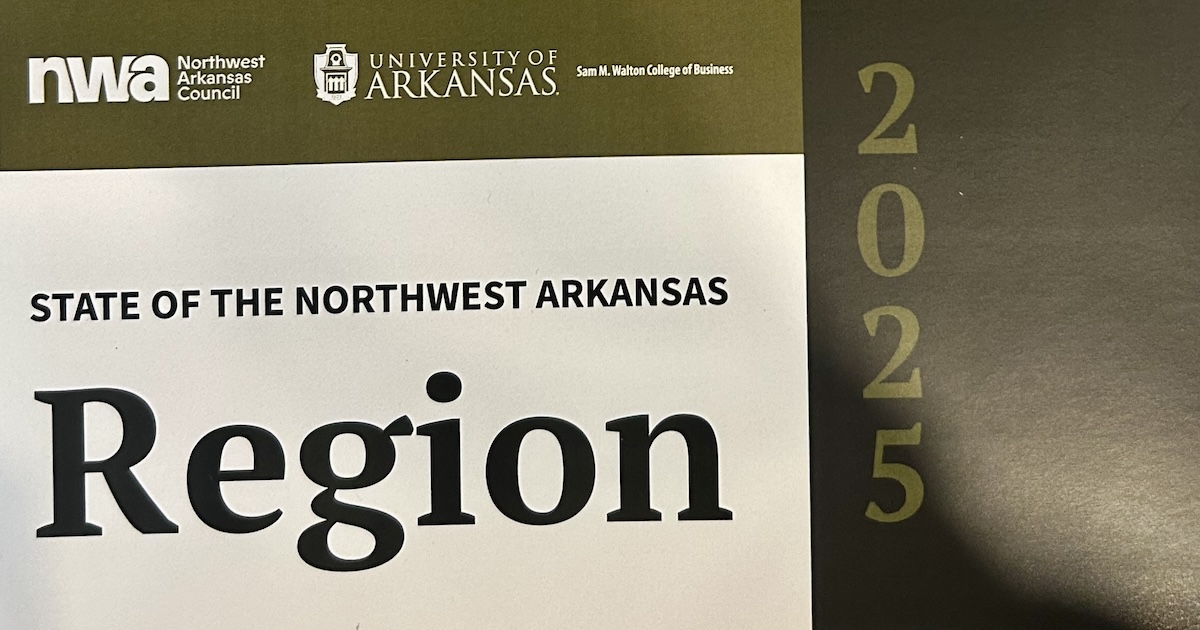
For more than a decade, the Northwest Arkansas Council[1] has focused on sustainable regional growth into future decades. Council leaders said Thursday (Oct. 23) that “collective commitment” will be needed to achieve that and other goals.
The council annually benchmarks itself against high-performing metro areas in hopes of raising the bar on metrics like average wages, business establishment, population growth and research and development (R&D) expenditures.
In cooperation with the University of Arkansas, the council held its State of the Region luncheon in Fayetteville on Thursday to discuss the wins and opportunities to do better before more than 400 people who attended the luncheon.
“Northwest Arkansas has real momentum, but keeping pace with the nation’s top regions will require bold action and collective commitment,” said Nelson Peacock, CEO of the Northwest Arkansas Council. “To stay competitive, we need to ensure we’re driving innovation, growing research and workforce and planning early for growth so housing and infrastructure can meet future demands.”
He told Talk Business & Politics this year’s report[2] indicated progress in areas like employment, which continues to outshine the rest of the state and nation. Particularly, high-tech job creation was up more than 8% and outperformed the peer regions as well.
Also, he mentioned that median household incomes in 2024 were $81,208, up 4.5% compared with 2023, but last in the peer group. The same is true for R&D spending at the University of Arkansas, which rose 20% to $221.5 million in 2024. However, it’s still half as much as the next closest peer – Des Moines – at $420.8 million. Raleigh, N.C., won that metric with total R&D spending at $1.55 billion in 2024.
Minah Hall, principal at VisionFirst Advisors, commented in her keynote address about the assets and liabilities for Northwest Arkansas when it comes to recruiting new businesses from other states. She said a key advantage is the regional mindset and focus of Northwest Arkansas, which is a collection of four cities and several smaller towns joined by Interstate 49.
Hall said many Americans do not know where Arkansas is located, much less Northwest Arkansas. However, the region continues to rank among the top-performing metros in the country, and the lower average wages are an asset for any manufacturer or business looking to relocate, she said.
Mervin Jebaraj, executive director of the Center for Business & Economic Research[3] at the UA, said while average wage growth has been good, median income still lags the peer regions. He said a big reason for the higher median income is that companies have recruited more degree-holding job candidates to Northwest Arkansas. This helped raise the percentage of adults holding bachelor’s degrees as well. That metric was 38.2% in 2024, and while it improved from around 32% it is still well below the Durham-Chapel Hill region in North Carolina at 54.7%, the highest among the cohorts.
Home prices remain a challenge, and they continue to rise in Benton and Washington counties. Part of the problem is that demand is outpacing supply. Jebaraj said Bentonville’s median home price is over $500,000, which is about as expensive as any of the peer cities in the report. Rogers is a bit cheaper at $470,000. In Springdale and Fayetteville, the median prices are around $370,000. He said sales are still outperforming 2018 and 2019 metrics despite higher interest rates.
New multifamily rental property continues to go up around the region and vacancy rates remain low at around 3%. He said average rents are now over $1,100 per month, which reduces home affordability. One area Jebaraj focused on was the need for more diversified housing and the need for more sewer and water treatment infrastructure.
“All the zoning codes in the world are not going to build more affordable housing if that zoning is not prepared with new water and sewer infrastructure to go along with it,” he said. “Sprawling into smaller towns is not possible if their sewer systems won’t handle the extra load. You are seeing development moratoriums in some of our small cities. You’re seeing development moratoriums in some of our larger cities, depending on where that development is happening.”
He expects the Federal Reserve will lower rates by 0.25% in its next two meetings, but he does not expect mortgage rates will soon fall below 6%. Jebaraj said tariffs are having an impact on trade as the overall effective rate is 18% – not as high as originally thought but much higher than last year. Jebaraj said the two things propping up the national economy are consumers continuing to spend and business investment in chips and data centers. He said those two skinny legs are prone to wobbling.
Related
References
- ^ Northwest Arkansas Council (nwacouncil.org)
- ^ this year’s report (online.flippingbook.com)
- ^ Center for Business & Economic Research (walton.uark.edu)
